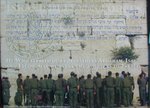
Until recently, it was possible to believe that whatever Ahmadinejad's intentions, Iran was a long way from acquiring the capabilities it needs to achieve its goals. But a blue-ribbon commission has reported to Congress on what appears to be an Iranian drive to obtain the means to carry out an EMP (electro-magnetic pulse) attack.
An EMP attack is produced by launching a ballistic missile with a nuclear weapon attached — and detonating it high above the Earth. This produces a massive pulse of ionized particles that could damage or even wipe out many electrical and information systems. Such an attack would disrupt telecommunications, banking and finance, fuel and energy, food and water supplies, emergency and government services and much more, threatening millions of lives.
We've seen a blacked-out Southeast Texas in the wake of Hurricane Ike. We've seen New Orleans after Katrina. Now imagine that scenario over most of the continental United States. There would be a "world without America" — at least as we know it.
No one disputes that Iran is developing a robust long-range missile force. Few question that Ahmadinejad's regime is working on nuclear weapons development. Less well known is that Iran has conducted missile tests from sea-based platforms, detonating warheads at the high-point of the missile trajectory, rather than the aim point over the target. These facts have now been documented in official government reports.
Connect the dots, and you find the picture of a workable research program for developing a covert means to deliver an EMP attack against the United States.
A short-range ballistic missile could be carried on one of the thousands of commercial freighters sailing under "flags of convenience" that sail around U.S. waters every day. Without ever piquing the interest of the Navy, the Coast Guard, or the Customs and Border Protection, that ship could sail within range and deliver its payload over American territory. Even a modest warhead placed at the right spot over the East Coast could take down 75 percent of the electrical grid.
The genius of such a covert attack is that it doesn't come with an obvious "return address." The ship might be registered in Liberia. The crew might be Lebanese. The ship might disappear into the night — or be scuttled quietly.
Another advantage for a would-be attacker is the bang that can be achieved for the buck. An EMP attack would allow an enemy to wreak an enormous amount of destruction for a modest investment. It would mean no electricity, no food on the shelves, no phone, no fuel deliveries. Life would look more like the barter system of the 19th century, not to mention the millions that would die from traffic accidents, fires, failed hospital equipment, disease and the other chaos that would result from such an attack.
A lot can be done to deal with this terrible threat. For starters, we need to build comprehensive missile defenses that can shoot missiles down fired anywhere shortly after they lift off. We also need to develop national plans to mitigate vulnerabilities to an EMP attack and recover quickly from a strike if one does occur.
America, however, also needs to dust-off its nuclear deterrent. Of all the nations that could pull off an EMP attack or hand that capacity to a transnational terrorist group, Iran is the only country that has directly threatened to destroy the United States. While much America's infrastructure is vulnerable to EMP, the nuclear strike force is not. We need to inform Iran that if an EMP attack were unleashed on America, Iran could well be held responsible and suffer massive nuclear retaliation.
Perhaps deterrence won't work. Middle East scholar Bernard Lewis argues that to a devout believer in Ayatollah Khomeini's apocalyptic ideology, mutually assured destruction may be "more an inducement than a deterrent." Still, it's worth making it clear that a steep price will be paid for such an attack.
In the end, President Reagan was right: Massive retaliation is not a morally supportable option when there are real alternatives. Comprehensive missile defenses, vigorous counter-proliferation programs, and making U.S. infrastructure more resilient are really the best ways to protect and defend the nation. The next president needs to make these a priority.
Indeed, demonstrating that America takes the threat seriously is perhaps the best message we could send to Ahmadinejad and those he represents.
Article first ran on The Houston Chronicle - Copyright 2008.
FamilySecurityMatters.org Contributing Editor James Jay Carafano, Ph.D., is a leading expert in defense affaires, intelligence, military operations and strategy, and homeland security at the Heritage Foundation. Feedback: editorialdirector@familysecuritymatters.org.
Clifford D. May is president of the Foundation for the Defense of Democracies.
You can find this online at: http://www.familysecuritymatters.org/publications/id.1532/pub_detail.asp
COPYRIGHT 2008 FAMILY SECURITY MATTERS INC.
































 While doing IDF (Israel Defence Forces) reserve duty on a mountain overlooking the
While doing IDF (Israel Defence Forces) reserve duty on a mountain overlooking the 





No comments:
Post a Comment